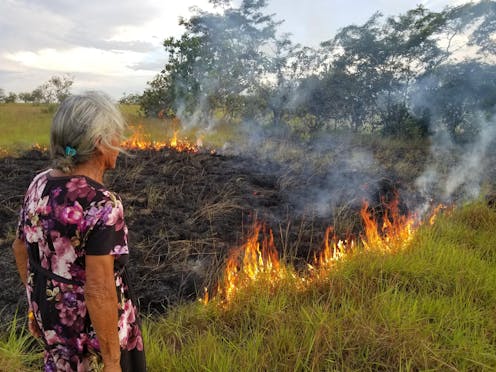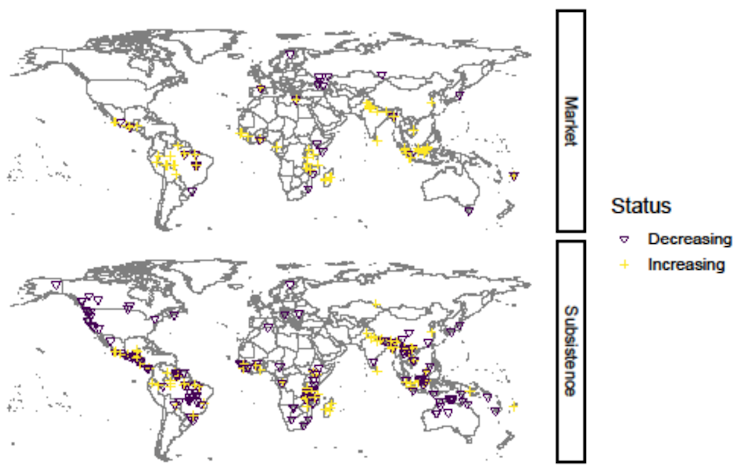
Greenhouse gas emissions continue to climb, and so you might expect more of Earth’s surface to be engulfed by fires each year. But satellite data shows that the reverse is true: the area of the world’s land burned by fires shrank in recent decades.
That might not be a good thing, though. Our research suggests that many of the fires no longer being set are controlled fires, which are important for rural livelihoods and ecosystems.
Some fires grow into vast and destructive wildfires. But controlled fire use is an essential part of smallholder farming, hunting and gathering that is oriented towards subsistence: mostly feeding the household rather than deriving profit in a market.
In Mexico, Maya people clear patches of forest using fire to allow small-scale farming of corn, beans and squash, before leaving these areas in fallow to regenerate. The cattle grazed by Oromo people in Ethiopia’s Bale Mountains prefer the fresh growth that follows burning, while fire promotes black oak acorns valued by Native Americans in California.
Fire is intimately tied to human cultures, but plants and animals in many ecosystems have also evolved to benefit from the fires people set. In grasslands, the frequent, small fires set by people can create biodiverse mosaics of vegetation, including new growth where animals can find fresh forage, and bushier areas that provide shelter. Until the vegetation builds up again, recently burned areas in these patchwork landscapes act as firebreaks, limiting the spread of wildfires.

Climate change is expanding the period each year in which conditions are hot and dry enough for wildfires to ignite and spread. Firefighting alone will be insufficient to protect homes and habitats, or to reduce carbon emissions from wildfires. We must heed a recent report by the Intergovernmental Panel on Climate Change that recommended how to avert the worst ravages of global heating, and support and learn from communities who continue to use fire in traditional ways.
Anti-fire policies
In recent centuries, the myth that all fires threaten natural resources and ecosystems has justified laws forbidding or severely restricting fire use in many countries. In Europe and European colonies, fires set by indigenous peoples were heavily suppressed.
Today, economic policies and market forces reduce fire use, especially that associated with subsistence activities. Historically, some fires, such as those set to summon fresh growth for game or livestock, occurred across large swathes of land, like the tropical savannas of the Brazilian Cerrado. As these landscapes have been privatised and converted to commercial uses, like large soybean plantations, traditional fire use has been squeezed out.

Government subsidies and land ownership reforms often encourage farmers to grow crops for the market on fixed and privately owned plots of land, instead of subsistence crops grown on temporary plots that are cleared with fire and then left to regenerate. Payment schemes designed to offset carbon emissions or deforestation, can restrict traditional fire use further, like in Mexico, where farmers are paid to stop farming in certain areas.
When people are forced to stop setting controlled fires, it can undermine their culture, livelihoods and ecosystems. For Borana pastoralists in Ethiopia who have stopped burning in rangelands, encroaching bushes and scarce forage make it more difficult to graze cattle. Without patchy human-made fire, vegetation becomes more uniform and supports less wildlife, like in Australia, where Martu hunting fires nurture hill kangaroo populations.
Without frequent, controlled burning, the risk of wildfires increases. This is the case in areas of the Cerrado where Xavante people no longer use fire for hunting. When fire use declines or becomes stigmatised, communities can also lose the traditional knowledge and local forms of governance that ensure those burns are carefully controlled.
Our research shows that economic policies and market forces are driving the diminishing use of fire for subsistence. But they are also increasing fire use in commercial agriculture. For example, in areas like the Indian trans-Gangetic plains where government policies are driving smallholder agriculture to intensify, farmers have started burning crop residues as the quickest means of preparing the land after combine harvesting for planting multiple annual crops. Air pollution from such widespread burning threatens public health and the climate.
Read more: Amazon fires trap farmers into poverty – and into setting more fires
Support for burning in livelihoods
Recognising that controlled fires reduce wildfire risk, state agencies responsible for fire management in the US, such as the US Forest Service, have favoured “prescribed burning” since the 1970s. Some of these programmes have been explicitly modelled on Indigenous fire use, or have even been used by Indigenous people to carry out the burning. In Australia, Aboriginal rangers are paid for prescribed burning through net carbon emissions reduction schemes.
Even where they try to mimic traditional burning patterns, most agencies conducting prescribed burning seek control over where and when fires take place. But livelihood practices defy such attempts at standardisation, and commandeering them further marginalises those holding traditional knowledge about fire.
Fire can sustain both people and nature. Programmes and policies intended to harness this must respect subsistence-oriented and smallholder fire use and make space for controlled fires as they are already practised within livelihoods.
Cathy Smith receives funding from the Leverhulme Trust.
Jayalaxshmi Mistry receives funding from the Leverhulme Trust.
Ol Perkins receives funding from the Leverhulme Trust and is a member of the UK Labour Party.
This article was originally published on The Conversation. Read the original article.





!["[T]he First and Fifth Amendments Require ICE to Provide Information About the Whereabouts of a Detained Person"](https://images.inkl.com/s3/publisher/cover/212/reason-cover.png?w=600)

